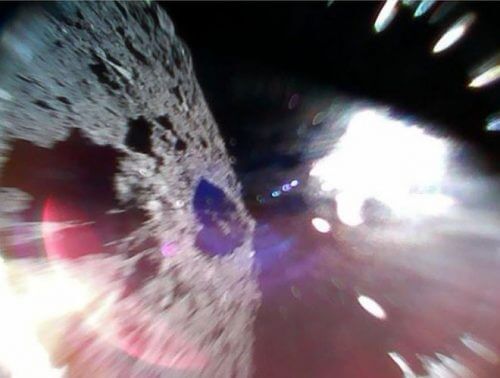The spacecraft separated yesterday (21/9/2018) from the Yabosa 2 mother spacecraft, but only today did they make contact as mentioned

This dynamic image was taken by the 1A probe on September 22 at around 11:44 Japan time (15:44 Israel time). The image shows the surface of the asteroid Ryugo during a jump. In the left half of the image, the surface of Ryogo is visible, while the bright spot on the left side was created as a result of exposure to sunlight. Photo: Yabusa 2 project, Japanese space agency JAXA.
After more than a day of communication blackout, it turned out that the robotic probes had successfully landed on the asteroid Ryugo and transmitted raw images from their new home.
The spacecraft separated yesterday (21/9/2018) from the Yabosa 2 mother spacecraft, but only today did they make contact as mentioned.
In a message on Twitter, the Japanese space agency said that its people are sorry for making the whole world wait. We confirm that MINERVA-II1 consisting of two robotic probes - 1A and 1B has landed on the asteroid Ryogo. The condition of the probes is good and they transmit images and data. We can also confirm that they move on the surface. #asteroidlanding
Yabusa 2 arrived at Ryugu (1999JU3) in June of this year after a three and a half year journey in space. On October 3, it is supposed to release another spacecraft called Maska, which was developed by the German Space Agency (DLR) together with the French Space Agency - CNES (whose flight computer was developed and built by the Israeli Ramon Chip company) and towards the end of October it is supposed to descend on its own to the ground and collect soil samples that scientists estimate were preserved from the time of the formation of the solar system, about 4.5 billion years ago to bring them to Earth.
Before leaving Ryugu next year, the Hayabusa2 mothership will release another tiny lander.
Scientists hope that studying the kilometer-long asteroid, which is composed of primordial material as it was in the early days of the solar system, will help them understand the origins and evolution of Earth and other planets. As its name indicates, this is the second mission in the series, when the Yabosa 1 "Falcon" spacecraft in Japanese was a spacecraft that managed to collect samples from an asteroid and return them to Earth about four years ago, at the end of a journey full of hardships and mishaps both during the hijacked descent to obtain the sample and on its way back home.
More of the topic in Hayadan:
- The Japanese Space Agency has lost contact with two small spacecraft that separated from the Yabusa 2 and were on their way to land on the asteroid Ryogo
- Towards the landing of MASCOT on the asteroid Ryogo from the spacecraft Yabosa 2: the operation manager talks about the planning
- The spacecraft is Japanese, its landing computer is Israeli

6 תגובות
Another key Israeli component in the project
Within MASCOT there is another central Israeli component of the company "Recor Systems"
K508 cryogenic cooler that cools an infrared detector inside the MicrOmega microscope
hyperspectral infrared microscope for in situ mineralogical analyzes of the ground, developed by the IAS (Institut d'Astrophysique Spatiale)
Link to MicroOmega description:
https://mascot.cnes.fr/en/MASCOT/GP_micromega.htm
Photos:
https://mascot.cnes.fr/en/MASCOT/photos_instruments.htm
One of the probes that landed has a cryogenic refrigerator made by the Ricor company in the Ein Harod Ihud group.
Found inside an infrared macroscope to examine minerals on the asteroid
On the net are additional very accurate pictures of the asteroid that the Japanese spacecraft is investigating. It's worth understanding.
The algorithms from the field of optimal control used to land a vehicle on a planet and return it to the mother spacecraft
They were originally designed in the sixties at least on the American side, by the NASA mathematician whose character appears in the film about the 3 black women who cracked the glass ceiling of black women in NASA. Kathryn Johansson.
The algorithm appears in KIRK's scientific book on optimal control for example. Useful mathematics at its best. In the film, they did not go into the theory for obvious reasons, so it is less clear what the big fuss is about her theory. She defined and solved the problem: bring the lander to a position where it will hit the star at minimum speed, bring the lander to a position close to the mother vehicle, using control parameters: momentum of engines and their direction. This is a control problem: an optimal momentum activation is required, while defining constraints on the problem. Today it is a very advanced field of research, specifically for satellites and spacecraft. Bring an array of satellites into synchronized motion relative to each other. Not as easy as everyone thinks.
I was happy to hear that the relationship with the probes was renewed. Kudos to Japan! Let's also hope for continued success in the other missions of Hibusa 2,
Happy new year to everyone
Yehuda
The ability to land on a moving asteroid has so far been reserved for Europe and Japan. Landing on a planet includes the superpowers.
Impressive technological ability.